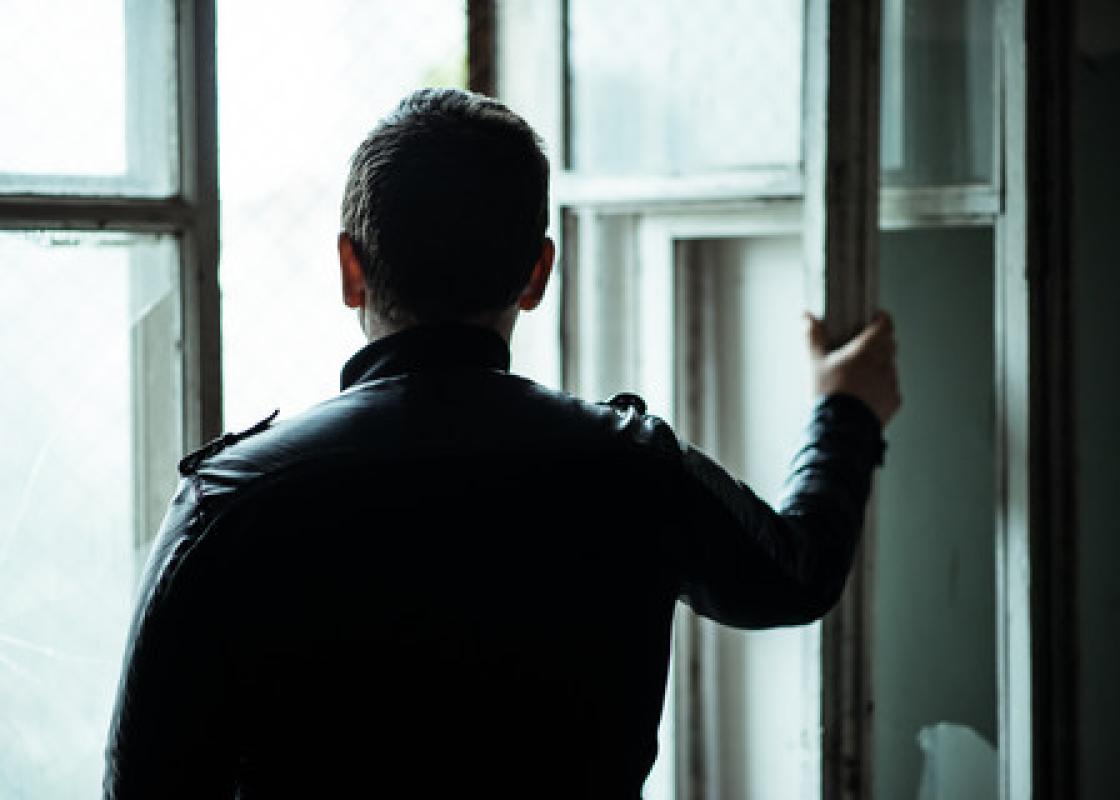“There is little difference between how men and women handle being exposed to domestic violence,” says criminologist Yngvil Grøvdal.
She is one of the researchers behind the report “Men at crisis centres” (Menn på krisesenter), based on qualitative interviews with 16 men. 14 of them were exposed to violence from a female partner, while two were exposed to violence from male partners.
The 16 men were recruited to the survey through the three crisis centres with most male users at the time of the survey in 2012.
In the new report, Grøvdal and her colleague Wenche Jonassen from Norwegian Centre for Violence and Traumatic Stress Studies (NKVTS) look at men who are victims of domestic violence and their experiences with crisis centres.
“As far as we know, Norway is the only country where men are legally entitled to access at crisis centres,” says Grøvdal.
The men
Ten of the interviewees in the report were ethnic Norwegians, one was a European, and five were originally from non-western countries. Half of the men who were victims of female violence had children with the woman. All except two had ended their relationship with the abuser when they were interviewed.
The men were generally satisfied with their experiences with the staff at the crisis centres. In particular, they were impressed by the way the staff made the most out of limited or lacking resources.
“All in all, the men were very satisfied with the staff at the crisis centres and their efforts,” says Grøvdal.
“This may be partly due to the selection. The crisis centres would probably not have recruited people they know are unhappy with the work they do. But it also appears that these men had low expectations in the first place. This may be due to their perception of crisis centres, but some of them had bad experiences from the general support system. This may lead to lower expectations the next time you seek help,” she says
The universally human
Five years ago, in January 2010, the Crisis Centre Act was passed. From then on, the municipalities have been responsible for the crisis centres, and access has become gender neutral.
“Men who are exposed to domestic violence have many of the same needs as female victims of domestic violence. Something universally human seems to come into play when you are exposed to violence from your partner or someone you have chosen to share your life with. This is probably one of the reasons why the competence at the crisis centres is perceived as relevant for men as well as for women,” says Grøvdal.
Fear of more violence, shame, anxiety related to how the children will handle the situation, and warm feelings for the violent abuser are reoccurring elements in both men’s and women’s stories about their lives with violence.
Men are more worried about not being believed when they talk about the violence than women are.
Shameful
Several of the men in the survey expressed shame of being victims of violence from a woman. It doesn’t agree with their own or society’s ideas of what men are or are supposed to be.
“In my culture it is shameful to tell someone that I’ve been hit by a woman. No one would believe it either. Neither did I dare to return the violence, in fear of being deported [out of the country].”
This is a quote from “David”, an African man in his thirties. David’s wife came to Norway before him, and worked in a nursing home. When David came to Norway on family reunification, he had problems getting work and getting integrated into Norwegian society. His wife eventually started taking control of his life, she often yelled at him, and threatened him by saying that her father and brothers would beat him up. She also became violent herself: During a fight she spat him in the face, hit him in the face with a flat hand, and she threatened him with a knife several times.

With the proviso that such categories are problematic, the researchers have categorised the violence into aggravated violence, less aggravated violence, and mental abuse. One example of aggravated violence from the research material was one who had his eye torn out. Other examples of aggravated violence may be when the abuser uses a knife, and reoccurring violent episodes. So-called less aggravated violence is violence that causes low risk of physical damage such as pulling the hair, spitting, pinching, and so on.
“Although many of the reactions and actions from the interviewed men are similar to those of women in the same situation, men appear to be more worried about not being believed when they talk about the violence than women are,” says Grøvdal.
“Several said that no one would believe that they had been victims of violence from a woman. Some said their partner had told them that no one would believe them.”
The ridiculed victim
The men’s fear of not being believed is not unfounded.
“Due to this survey we now know that the crisis centres have encountered police who don’t take men seriously and that the men themselves experience not being taken seriously by The Norwegian Welfare and Labour Administration (NAV) and the Child Welfare Service,” says Grøvdal.
She also refers to other research which shows that men face problems being taken seriously when they say that they have been abused by a female partner.
See also: Beaten by their wives
Among of the research Grøvdal is referring to is the book “The invisible violence: men who are victims of domestic violence by women” (Den usynliggjorte volden: om menn som utsettes for partnervold fra kvinner) from 2013, in which Tove Ingebjørg Fjell, professor of Cultural History at the University of Bergen, has interviewed several male victims of domestic violence.
Fjell has also written an article about how men who are victims of violence from a female partner are often ridiculed in comedy shows.
“But we don’t find it as amusing if a man does the same to a woman,” says Grøvdal.
Women can also take up arms
“On average, men are physically stronger than women, thus many people believe that women’s violence cannot be very serious. What do you think about these attitudes?”
“In a way this makes women less all-human, if we claim that they’re incapable of performing actions that we consider unacceptable. Women can also take up arms or weapon-like objects. The action can happen very sudden, not giving the man the opportunity to defend himself. Moreover, some men are afraid to defend themselves as they fear that this will be used against them,” says Grøvdal.
“We also know that violence can come like a bolt from the blue.”
One of the men in the study experienced his partner using a knife against him, another woman burned her partner with a hot object, possibly an iron – he couldn’t see it, as she attacked him from behind.
“Neither is it true that all women are weaker than all men,” Grøvdal points out.
“We know that some men, although not as many as women, are exposed to life-threatening violence. And we need to deal with that.”
In a way it makes women less all-human, if we claim that they’re incapable of performing actions that we consider unacceptable.
Gender segregated crisis centres
The Norwegian Institute for Welfare and Ageing’s (NOVA) evaluation of crisis centres shows that women are offered different services than men are. The women are to a much higher degree part of a community.
“Many men at the crisis centres live alone. The children who accompany their father to the crisis centre are not offered the same services as children accompanying their mother. The services offered to the women often include professional services for the children, whereas the children accompanying the men risk being more isolated,” says Grøvdal.
In the consultation papers to the Crisis Centre Act, an important requirement was that men and women were to live completely separated at the crisis centres. In many places, this means that the men are geographically separated from the women, often placed in apartments or, in some cases, hotel rooms which are rented for a shorter period of time.
“I think it is both interesting and paradoxical that the crisis centres are concerned that the women who have been victims of violence from a male partner should not have to meet any men at all, whereas nobody seems to care if men who have been victims of violence from a female partner have to meet women. This probably has to do with gender stereotypes,” says Grøvdal.
Some of the staff also experienced that as a result of the 2010 Act they were assigned more tasks without being provided increased funding accordingly.
See also: Girls beaten by their boyfriend avoid the word 'violence'
The crisis centre’s competence
The crisis centres were established in the 1970s by women who had been exposed to domestic violence and wanted to help other women in similar situations. They wanted domestic violence and the abuse of women to be regarded as a public, not a private, problem.
Today we talk about violence within close relations and domestic violence in order to emphasise that “he” is not always the abuser and “she” is not always the victim.
“We know from research that more women than men are exposed to aggravated violence and that more women than men are killed by their partner. But this doesn’t mean that men, cannot be victims of this type of violence,” says Grøvdal.
She calls for more research on how the police and staff within the health and social services understand gender in general and on how they treat men who have been exposed to domestic violence in particular.
“It is problematic if we pit men who have been exposed to domestic violence against women in similar situations. Everyone who needs it should receive protection and help regardless of whether they’re men or women.”
Translated by Cathinka Dahl Hambro
Grøvdal has also written a PhD on how women who have been exposed to domestic violence experience their encounter with the legal system.
Reference:
Yngvil Grøvdal and Wenche Jonassen: Menn på krisesenter (“Men at the Crisis Centre”). Report 5/2015. Norwegian Centre for Violence and Traumatic Stress Studies (NKVTS).
- 16,3 % men and 14,4 % women say they have experienced so-called less aggravated domestic violence such as pinching, scratching, pulling of the hair or flat hand slapping some time during their lives.
- However, women experience more of these incidents during their lives than men do.
- 8,2 % women and 1,9 % men have been exposed to aggravated domestic violence such as kicking, strangleholding or being beaten up.
- Two thirds of both men and women who are exposed to aggravated domestic violence from their partner are also exposed to controlling behaviour from their partner.
- The Criminal Police Centre’s (Kripos) national survey of criminal deaths from 2012 shows that 62 women and 9 men were killed by their partners during the period 2003-2012.
Source:
Vold og voldtekt i Norge. En nasjonal forekomststudie av vold i et livsløpsperspektiv. (Report from NKVTS. In Norwegian)



